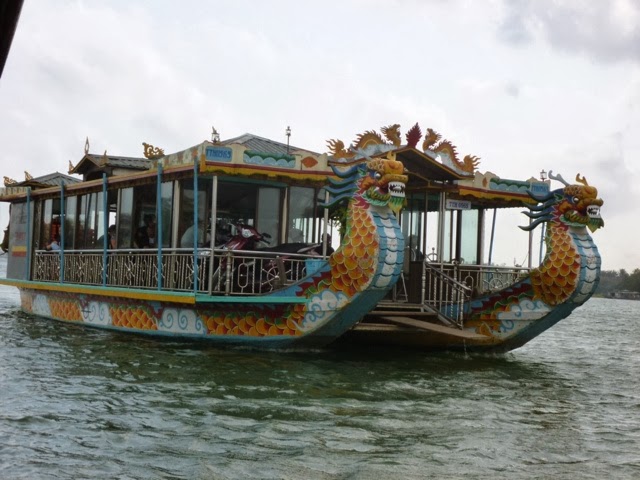So our holidays ended and the family headed home... It was an emotional parting as they left me at Da Nang railway station
But I was looking forward to heading up the coast on a very scenic ride to Hue, about 2 hours north. This is probably the most scenic part of the north south Reunification line, but it was very grey and the train windows were dirty.... So no photos! The line climbs up and winds round through several tunnels to cross the Hai Van Pass, also known as Sea Cloud Pass.... I wonder why!
I arrived at Hue station....
The next day I explored the Citadel, the ancient forbidden city of the emperors. Hue became the capital of Vietnam in the early nineteenth century when the emperor decided to move his capital from Hanoi to make a new one that was more central. When the North Vietnamese army took control of Hue in the American war and raised their flag in the ancient citadel, the Americans eventually decided that bombing was the only way they could win Hue, and so they virtually flattened it. Some buildings did survive, and others have been restored, but the work is ongoing and there is still much to do.
The flagpole where the north Vietnamese flag was raised and which still holds much patriotic symbolism for the Vietnamese people. Below is the gateway into the citadel...
Some buildings have been restored...
All that is left here is the outline where the buildings once stood.....
and the bullet holes....
The next day I went on a tour outside the city to some of the numerous tombs of the emperors. I travelled by dragon boat down the Perfume River
To the beautiful seven tiered pagoda, Thien Mu.
It was from here that a Buddhist monk travelled to Saigon in 1963 and then set himself on fire in protest against the south Vietnamese government policies.... Photographs of which were sent around the world....
This was the tomb of emperor Khai Dinh who died in 1925.
And this was the tomb of Tu Duc, emperor from 1848-83, and who lived here when he could escape from duties in the Royal citadel, and was subsequently buried here.
I met a lovely Dutch lady in the same hotel as me, and we did a trip together to the Vinh Moc tunnels in the DMZ. I didn't do the full tour of the DMZ as it is very spread out and you tend to spend longer in the bus than at the sights... The DMZ at the 17th parallel is where the Geneva Convention deemed that the divide should be between North and South Vietnam, along the Ben Hai River... This De Militarised Zone between North and South Vietnam experienced some of the heaviest bombardment and heavy fighting of anywhere during the war, to the extent that the villagers actually dug tunnels and moved underground to live in them, for days at a time over a period of several years.
This beautiful bronze mural in the museum shows the Vietnamese living underground while the Americans are raining bombs on them....
Families lived in dug out caves off the main tunnels, at depths between 12 and 23 metres underground.... The Vietcong also used the tunnels that the villagers had dug as a base for supplies and for fighting...
They had a maternity unit where 17 babies were born...
And access to the sea. Most of the villagers were farmers and fishermen and they came out of the tunnels for work but were always ready to return underground...
They had two wells, a toilet facility, meeting room, and 2km of tunnels. As the tunnels were built to be lived in, rather than mostly for fighting like the Cu Chi tunnels, they were made bigger. They have been enlarged slightly for tourists, and I could nearly stand up straight! We also had electricity, and they certainly didn't have that!
We also visited the site of the Battle of Ben Hai, to win the river crossing. There is a memorial there now, and a museum.... Lest we forget....





















No comments:
Post a Comment